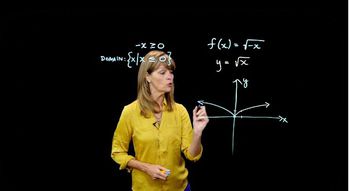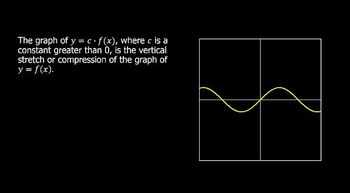Table of contents
- 0. Review of Algebra4h 16m
- 1. Equations & Inequalities3h 18m
- 2. Graphs of Equations43m
- 3. Functions2h 17m
- 4. Polynomial Functions1h 44m
- 5. Rational Functions1h 23m
- 6. Exponential & Logarithmic Functions2h 28m
- 7. Systems of Equations & Matrices4h 6m
- 8. Conic Sections2h 23m
- 9. Sequences, Series, & Induction1h 19m
- 10. Combinatorics & Probability1h 45m
3. Functions
Transformations
Problem 64a
Textbook Question
In Exercises 64–66, begin by graphing the square root function, f(x) = √x. Then use transformations of this graph to graph the given function. g(x) = √(x + 3)
 Verified step by step guidance
Verified step by step guidance1
Start by graphing the basic square root function, \( f(x) = \sqrt{x} \). This graph begins at the origin (0,0) and increases gradually to the right, forming a curve that gets less steep as x increases.
Identify the transformation needed to graph \( g(x) = \sqrt{x + 3} \). Notice that the expression inside the square root, \( x + 3 \), indicates a horizontal shift.
Understand that adding a constant inside the square root function, \( \sqrt{x + 3} \), results in a horizontal shift to the left by that constant. In this case, the graph of \( f(x) = \sqrt{x} \) will shift 3 units to the left.
Apply the transformation to the graph of \( f(x) = \sqrt{x} \). Shift every point on the graph of \( f(x) \) 3 units to the left to obtain the graph of \( g(x) = \sqrt{x + 3} \).
Verify the transformation by checking key points. For example, the point (0,0) on \( f(x) \) will move to (-3,0) on \( g(x) \), and the point (1,1) will move to (-2,1).
Recommended similar problem, with video answer:
 Verified Solution
Verified SolutionThis video solution was recommended by our tutors as helpful for the problem above
Video duration:
1mPlay a video:
Was this helpful?
Key Concepts
Here are the essential concepts you must grasp in order to answer the question correctly.
Square Root Function
The square root function, f(x) = √x, is defined for x ≥ 0 and produces non-negative outputs. Its graph is a curve that starts at the origin (0,0) and increases gradually, reflecting the relationship between x and its square root. Understanding this function is crucial as it serves as the foundation for applying transformations.
Recommended video:

Imaginary Roots with the Square Root Property
Graph Transformations
Graph transformations involve shifting, stretching, compressing, or reflecting the graph of a function. In this case, the transformation g(x) = √(x + 3) represents a horizontal shift of the square root function to the left by 3 units. Recognizing how these transformations affect the original graph is essential for accurately graphing the new function.
Recommended video:

Intro to Transformations
Horizontal Shifts
Horizontal shifts occur when a function is modified by adding or subtracting a constant inside the function's argument. For g(x) = √(x + 3), the '+3' indicates a shift to the left, meaning every point on the graph of f(x) = √x moves left by 3 units. This concept is vital for understanding how the graph of g(x) relates to f(x).
Recommended video:

Shifts of Functions

 5:25m
5:25mWatch next
Master Intro to Transformations with a bite sized video explanation from Nick Kaneko
Start learningRelated Videos
Related Practice
























